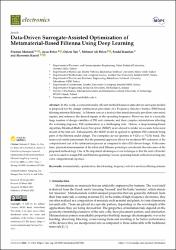| dc.contributor.author | Mahouti, Peyman | |
| dc.contributor.author | Belen, Aysu | |
| dc.contributor.author | Tarı, Özlem | |
| dc.contributor.author | Belen, Mehmet Ali | |
| dc.contributor.author | Karahan, Serdal | |
| dc.contributor.author | Koziel, Slawomir | |
| dc.date.accessioned | 2023-12-26T11:08:40Z | |
| dc.date.available | 2023-12-26T11:08:40Z | |
| dc.date.issued | 2023 | en_US |
| dc.identifier.citation | Mahouti, P., Belen, A., Tari, O., Belen, M.A., Karahan, S., Koziel, S. (2023). Data-Driven Surrogate-Assisted Optimization of Metamaterial-Based Filtenna Using Deep Learning. Electronics (Switzerland), 12 (7), art. no. 1584.
https://doi.org/10.3390/electronics12071584 | en_US |
| dc.identifier.issn | 2079-9292 | |
| dc.identifier.uri | https://doi.org/10.3390/electronics12071584 | |
| dc.identifier.uri | https://hdl.handle.net/20.500.12508/2812 | |
| dc.description.abstract | In this work, a computationally efficient method based on data-driven surrogate models is proposed for the design optimization procedure of a Frequency Selective Surface (FSS)-based filtering antenna (Filtenna). A Filtenna acts as a module that simultaneously pre-filters unwanted signals, and enhances the desired signals at the operating frequency. However, due to a typically large number of design variables of FSS unit elements, and their complex interrelations affecting the scattering response, FSS optimization is a challenging task. Herein, a deep-learning-based algorithm, Modified-Multi-Layer-Perceptron (M2LP), is developed to render an accurate behavioral model of the unit cell. Subsequently, the M2LP model is applied to optimize FSS elements being parts of the Filtenna under design. The exemplary device operates at 5 GHz to 7 GHz band. The numerical results demonstrate that the presented approach allows for an almost 90% reduction of the computational cost of the optimization process as compared to direct EM-driven design. At the same time, physical measurements of the fabricated Filtenna prototype corroborate the relevance of the proposed methodology. One of the important advantages of our technique is that the unit cell model can be re-used to design FSS and Filtenna operating various operating bands without incurring any extra computational expenses. | en_US |
| dc.language.iso | eng | en_US |
| dc.publisher | MDPI | en_US |
| dc.relation.isversionof | 10.3390/electronics12071584 | en_US |
| dc.rights | info:eu-repo/semantics/openAccess | en_US |
| dc.subject | Deep learning | en_US |
| dc.subject | Filtering antenna | en_US |
| dc.subject | Frequency selective surfaces | en_US |
| dc.subject | Metamaterials | en_US |
| dc.subject | Optimization | en_US |
| dc.subject.classification | Frequency Selective Surfaces | |
| dc.subject.classification | Radomes | |
| dc.subject.classification | Polarization | |
| dc.subject.classification | Electrical Engineering, Electronics & Computer Science
- Wireless Technology
- Metamaterials | |
| dc.subject.other | Frequency-Selective surfaces | |
| dc.subject.other | Horn antenna design | |
| dc.subject.other | Wide-Band | |
| dc.subject.other | Dielectric lens | |
| dc.subject.other | Ridge horn | |
| dc.subject.other | Gain | |
| dc.subject.other | Ultrawideband | |
| dc.subject.other | Performance | |
| dc.subject.other | Interference | |
| dc.subject.other | Efficiency | |
| dc.title | Data-Driven Surrogate-Assisted Optimization of Metamaterial-Based Filtenna Using Deep Learning | en_US |
| dc.type | article | en_US |
| dc.relation.journal | Electronics (Switzerland) | en_US |
| dc.contributor.department | Mühendislik ve Doğa Bilimleri Fakültesi -- Elektrik-Elektronik Mühendisliği Bölümü | en_US |
| dc.contributor.department | İskenderun Meslek Yüksekokulu -- Hibrid ve Elektrikli Taşıtlar Teknolojisi Bölümü | |
| dc.identifier.volume | 12 | en_US |
| dc.identifier.issue | 7 | en_US |
| dc.relation.publicationcategory | Makale - Uluslararası Hakemli Dergi - Kurum Öğretim Elemanı | en_US |
| dc.contributor.isteauthor | Belen, Aysu | |
| dc.contributor.isteauthor | Belen, Mehmet Ali | |
| dc.relation.index | Web of Science - Scopus | en_US |
| dc.relation.index | Web of Science Core Collection - Science Citation Index Expanded | |
















